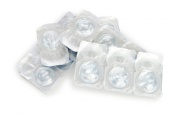Contents |
Understanding and Avoiding Contact Lens Complications: Polymegathism, Neovascularization and the Endothelial Pump
Introduction
Avoiding complications related to contact lens wear is easy: keep the lenses as sanitary as possible, clean and care for them as your eyecare practictioner recommends, and wear them as directed.
Three big long words describe a set of interrelated complications of contact lens wear that are the result of a decrease in oxygen levels at the surface of the eye. The cornea, the clear, dome-shaped structure that allows light to enter the eye, is sensitive to the flow of oxygen, which normally comes from the air around it and dissolved in the tears, which bathe and lubricate it. When the amount of oxygen getting through falls, in this case from interference by contact lenses, the cornea reacts by adapting itself in several possible ways.
"Endothelial pump" is the term used to describe the function of the cells lining the back wall of the cornea in removing excess water from the tissues, which then goes into the aqueous humour and circulates out of the eye normally. Without this pump, the cornea takes on excess fluid and becomes swollen. A swollen cornea is cloudy so vision is affected as well.
"Neovascularization" describes the growth of new blood vessels into the corneal tissue from the white sclera surrounding it. Normally, the cornea is an avascular tissue and completely free of arteries and veins, unless there is a problem with decreased oxygen. Once blood vessels grow into the cornea, they never disappear; they may become empty (“ghost” vessels) but never go completely away.
"Polymegathism" describes a characteristic look to endothelial tissues that is seen with the slit lamp, a piece of ophthalmic equipment that is a large microscope with a controllable light beam that eyecare practitioners use to evaluate ocular tissues. The normal appearance of endothelial tissue is one that might be described as looking like a honeycomb or chicken wire; that is, all the cells are about the same size and form a regular pattern with their neighbors so the cell walls match up on six sides, forming the honeycomb pattern. In polymegathism, the cells lose their regular honeycomb appearance and look more random, with larger and smaller cells randomly scattered across the tissue. This appearance indicates that the cornea is no longer able to maintain its normal function of removing excess fluids.
These particular complications are seen less often today because materials contact lenses are made from are much more breathable than in the past. However, eyecare practitioners do still see them, usually in patients who have been in contact lenses for a long time.
There are no symptoms that patients can monitor for themselves; there is no pain or irritation, and the onset of blurred vision from a swollen cornea is so gradual that most patients don’t notice it until it is well advanced.
The only way to diagnose and treat these particular complications is to have frequent and regularly-scheduled visits to the eyecare practitioner, who will use specialized equipment to measure and evaluate their presence.
Treatment
Oxygen must be allowed to get to the cornea. Usually, this can be accomplished by refitting the patient with one of the newer contact lens materials that are much less of a barrier to oxygen flow. It can also be improved by changing the fitting characteristics themselves, by using a lens that moves on the eye more, which increases the amount of tears being exchanged under the lens with normal blinking.
In addition, if the patient is wearing his or her lenses in an extended-wear modality, overnight wear should be discontinued immediately. If the cornea has reacted to decreased oxygen during the day that decrease is only worsened by closing the lids over the lens in sleep.
Frequent lens replacement will also help restore the cornea to pre-lens condition, because a fresh lens has no protein buildup that can get in the way. Daily disposable contacts are often the healthiest and most comfortable way to wear lenses.




